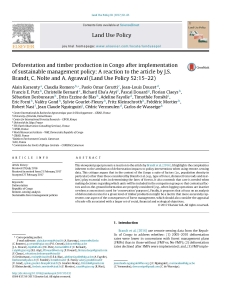Karsenty A., Romero C., Cerutti P.O., Doucet J.L., Putz F.E., Bernard C., Eba’a Atyi R., Douard P., Claeys F., Desbureaux S., de Blas D.E., Fayolle A., Fomété T., Forni E., Gond V., Gourlet-Fleury S., Kleinschroth F., Mortier F., Nasi R., Nguinguiri J.C., Vermeulen C., de Wasseige C.
This viewpoint paper presents a reaction to the article by Brandt et al. (2016). It highlights the complexitiesinherent to the attribution of deforestation impacts to policy interventions when using remote-sensingdata. This critique argues that in the context of the Congo a suite of factors (i.e., population density inparticular) other than those considered by Brandt et al. (e.g., type of forest, distance from roads and mar-kets) play essential roles in determining the fates of forests. It also contends that care is needed whenmaking decisions regarding which units will be included in the comparison group so that contextual fac-tors and on-the-ground information are properly considered (e.g., when logging operations are inactiveor when a concession is used for ‘conservation’ purposes). Finally, it proposes that a focus on an analysisof deforestation rates for a given level of timber production might be a metric that more accurately rep-resents one aspect of the consequences of forest management, which should also consider the appraisalof trade-offs associated with a larger set of social, financial and ecological objectives.
Consultez la notice complète de l’article sur ORBi

